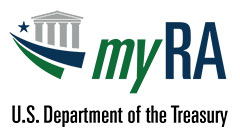U.S. Treasury to Retire the myRA Program
September 4, 2017 | Financial Planning, IRS Regulation, Tax Planning, Tax Preparation
 According to the U.S. Department of the Treasury, the My Retirement Account (myRA) program will be coming to an end, even though it was just created just a few years ago in 2014. As part of the Trump Administration’s effort to slim down wasteful spending where possible, the Treasury has decided this short-lived Roth IRA backed by the government isn’t cost effective.
According to the U.S. Department of the Treasury, the My Retirement Account (myRA) program will be coming to an end, even though it was just created just a few years ago in 2014. As part of the Trump Administration’s effort to slim down wasteful spending where possible, the Treasury has decided this short-lived Roth IRA backed by the government isn’t cost effective.
First Some Background on Roth IRAs
A Roth IRA is an individual retirement account that’s treated as a traditional IRA except where special rules apply. For 2017, individuals can make annual, nondeductible Roth IRA contributions up to $5,500, or $6,500 for those age 50 and older (or 100% of compensation if less). The total contributions for the tax year must be reduced by amounts that are put into all other IRAs.
When modified adjusted gross income (MAGI) exceeds certain limits, allowable contributions for 2017 are phased out. The ability to contribute disappears completely when MAGI is over $196,000 for married taxpayers and $133,000 for single taxpayers and heads of household.
The main attraction of a Roth IRA is that qualified distributions from these accounts aren’t included in the accountholder’s income, therefore not taxed. A qualified distribution is one that is made after a five-tax-year period that begins with the first tax year for which the taxpayer made a contribution to a Roth IRA that’s established for the taxpayer or by rolling over an amount from another type of IRA.
Qualified distributions can also be made:
- At or after death (to a beneficiary or estate);
- On or after the accountholder attains age 59 ½;
- For a first-time home purchase expense up to $10,000; or
- On account of disability.
The amount that is in excess of contributions is taxableforr distributions that aren’t qualified, and the amount includible in income is also subject to the 10% early withdrawal tax unless an exception applies.
myRAs
MyRAs became available through employers, backed and administered by the U.S. government in 2014. The program was described as being a safe, simple and affordable starter savings account to help low- and moderate-income taxpayers save for retirement. Based on a directive from then-President Obama, the Treasury introduced the myRA program.
A myRA is a Roth IRA authorized to hold only one type of investment, that is, a U.S. Treasury security which earns interest at the same variable rate as investments in the government securities fund for federal employees. The same rules that apply to private Roth IRAs also apply to myRAs, including the MAGI-based eligibility for contributions, maximum annual contributions and tax treatment of distributions.
MyRA participants have been permitted to save up to $15,000, or for a maximum of 30 years, in a myRA account. The account must be rolled over to a private sector Roth IRA when either of these limits is reached. This rollover allows savers to continue to grow their savings past the maturity of their myRA starter savings account.
The Retirement Account Will Retire
A recent review of the overall success of the myRA program shows that the cost to taxpayers for managing the accounts has been nearly $70 million even though demand for — and investment in — these accounts has been extremely low. On that basis, the Treasury announced on July 28th that the myRA program will phase out over the coming months.
New enrollments are no longer being accepted as a result. Existing myRAs remain open and accessible at this time, and individuals can continue to manage their accounts until further notice. Individuals can make deposits and their accounts will continue to earn interest. Funds in myRAs remain in an investment issued by the Treasury Department.
If participants have questions, they are encouraged to visit www.myRA.gov or call their myRA customer support numbers. Notices from the Treasury Department will be going out to account owners, detailing the coming changes and providing the necessary information on the next steps account owners should take and relevant deadlines for the transfer and closure of their accounts.
Jovita Carranza, U.S. Treasurer, sought to assure accountholders, saying “[w]e will be communicating frequently with participants to help facilitate a smooth transition to other investment opportunities.” She added that ample private sector investments exist that offer no account maintenance fees, no minimum balances and safe investment opportunities.
